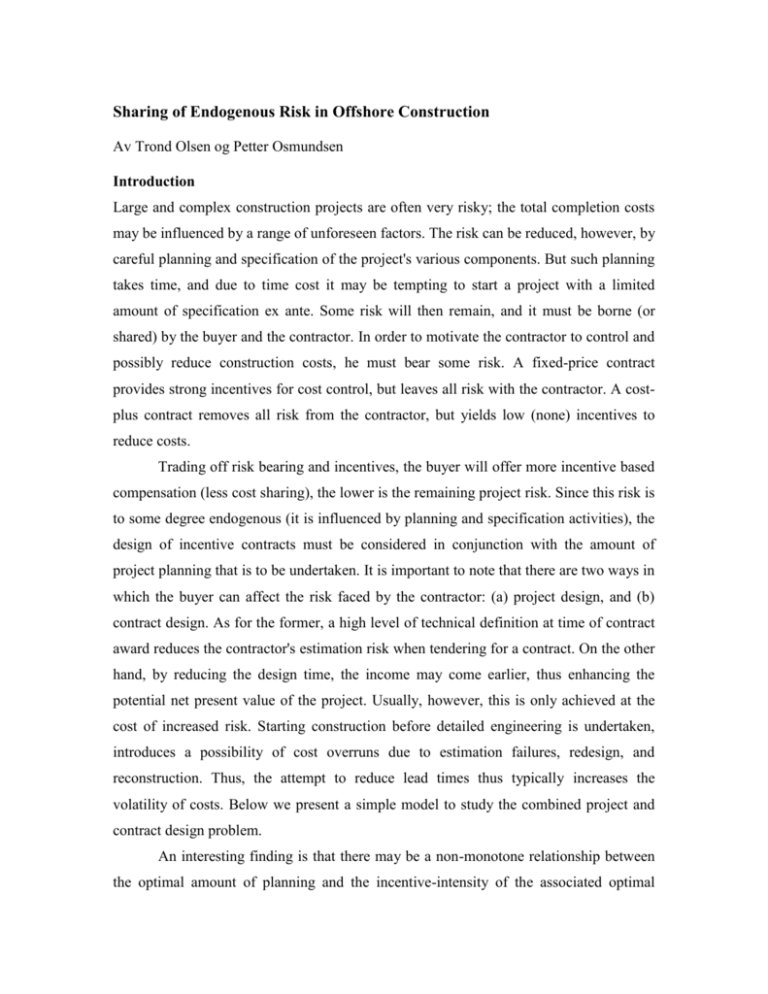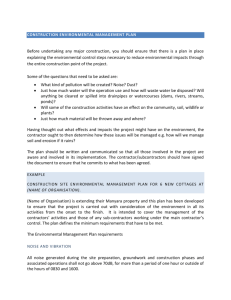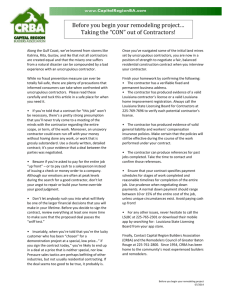Sharing of Endogenous Risk in Offshore Construction
advertisement

Sharing of Endogenous Risk in Offshore Construction Av Trond Olsen og Petter Osmundsen Introduction Large and complex construction projects are often very risky; the total completion costs may be influenced by a range of unforeseen factors. The risk can be reduced, however, by careful planning and specification of the project's various components. But such planning takes time, and due to time cost it may be tempting to start a project with a limited amount of specification ex ante. Some risk will then remain, and it must be borne (or shared) by the buyer and the contractor. In order to motivate the contractor to control and possibly reduce construction costs, he must bear some risk. A fixed-price contract provides strong incentives for cost control, but leaves all risk with the contractor. A costplus contract removes all risk from the contractor, but yields low (none) incentives to reduce costs. Trading off risk bearing and incentives, the buyer will offer more incentive based compensation (less cost sharing), the lower is the remaining project risk. Since this risk is to some degree endogenous (it is influenced by planning and specification activities), the design of incentive contracts must be considered in conjunction with the amount of project planning that is to be undertaken. It is important to note that there are two ways in which the buyer can affect the risk faced by the contractor: (a) project design, and (b) contract design. As for the former, a high level of technical definition at time of contract award reduces the contractor's estimation risk when tendering for a contract. On the other hand, by reducing the design time, the income may come earlier, thus enhancing the potential net present value of the project. Usually, however, this is only achieved at the cost of increased risk. Starting construction before detailed engineering is undertaken, introduces a possibility of cost overruns due to estimation failures, redesign, and reconstruction. Thus, the attempt to reduce lead times thus typically increases the volatility of costs. Below we present a simple model to study the combined project and contract design problem. An interesting finding is that there may be a non-monotone relationship between the optimal amount of planning and the incentive-intensity of the associated optimal construction contract. Little planning (and hence high endogenous project risk) may occur together with either low-powered or high-powered incentive contracts, while much planning occurs together with medium-powered contracts. (An inverse-U relationship between optimal planning and contract power, i.e. a U-relationship between endogenous risk and contract power.) The reason for the non-monotonicity is the two tensions affecting contract design. First, taking the project risk as given, it is the case that the more risk averse a contractor is, the less powerful (more of a cost-plus type) will the construction contract be. But second, given more risk aversion, it also pays to invest in planning to reduce the overall risk. Such a lower risk will in isolation call for a more powerful (more of a fixed-price type) construction contract. The two tensions produce the non-monotonicity. Across a sample of observations (where the underlying variation stems from contractors' varying degrees of risk aversion), we may then observe the nonmonotone relationships, as indicated in the figures below. Case: Norwegian Offshore Development Projects Optimal risk sharing between oil companies and contractors can be perceived as a tradeoff between the provision of incentives and optimal risk sharing. See Grossman and Hart (1983). For a discussion of optimal sharing of risk among the oil companies and the government (fiscal design), see Osmundsen (1999).}} Optimal risk sharing is simply to let the party with the lowest risk aversion to carry the risk. In most cases this would mean the oil company. These companies specialise in carrying risk, they often have high financial capacity, and are able to eliminate parts of the risk by holding a diversified portfolio of projects. On the Norwegian continental shelf they also form partnerships, reducing their risk exposure to the equity share they hold in each individual licence. Suppliers, the offshore construction industry, on the other hand, are less able to carry risk. One individual offshore development contract, that may amount to as much as one billion dollars, and last for several years, comprises a major part of the portfolio of a construction company. The need to provide incentives to the contractor, however, calls for much risk to be borne by the agent: the agent are provided incentives by making his compensation contingent on timely delivery and low costs. Optimal risk sharing is highly context specific, depending on the relative risk aversions of the contracting parties and on the extent to which provision of incentives is important for the realisation of the project objectives. The contractor's capability to carry risk, may however effectively limit the incentive intensity. Norwegian offshore construction companies have over the last ten years experienced low returns, and financial reserves are low. In the beginning of the 1990s, the Norwegian petroleum industry experienced a cost level that did not justify new offshore development projects. To reduce development time and costs drastically on the Norwegian shelf, economic and technical task forces were appointed, with members from the oil companies, the suppliers and government. This process, known as NORSOK, was inspired by the cost reduction initiative CRINE on the UK shelf. A consensus was reached in the Norwegian petroleum industry, to implement a number of organisational and contractual changes. Much attention has been devoted to reducing the lead time. Deep water offshore development projects are extremely capital intensive, and to get the field on stream at an early stage may be decisive for a positive project appraisal (net present value analyses). To reduce the development time, contract award (and to some extent fabrication) has started before detailed engineering is undertaken. This has led to a considerable increase in estimation risk. For a number of extraction facilities there has been considerable amounts of reengineering and refabrication, causing delays and cost overruns. In some cases this is due to updated information about the reservoir characteristics and a wish to implement new technology. In other cases the initial engineering and planning were inadequate. Previously, the oil companies (the licence groups, represented by the operators) coordidated deliveries from contractors that were specialised within project management, engineering, module fabrication, at-shore/inshore hook-up or marine operations. Today, the Norwegian \ offshore development market is dominated by 3 to 4 major entities marketing themselves as capable of carrying out total enterprise contracts and/or projects from concept development to offshore installation and start up. Hence, the project management tasks which previously had to be carried out by a project team managed by the client, have after 1994 been carried out by the major offshore contractors, regulated by EPCI-contracts (Engineering, Procurement, Construction, Installation). The large size of the contracts, and the new coordination tasks to be performed, implied a considerable increase of risk for the turnkey suppliers. In the previous fabrication contracts, founded on cost-plus principles, most of the risk was borne by the oil companies. In the EPCIcontracts, however, an even split of cost overruns and savings, relative to a target sum was introduced. There was a an upper limit to the cost overruns to be borne by the contractor, but this cap was substantial compared to the contractor's financial strength. Thus, in a situation of a considerable increase in risk, a higher fraction of the risk is borne by the contractors. The performance of the new contractual and organisational solutions in Norwegian offshore development projects was evaluated by a government study (Government Report NOU 1999:11). (The idea for this paper arose during Osmundsen's work on a scientific attachement to this report.) For the new type of development projects, implemented after 1994, the study reports aggregate cost overruns exceeding 4 billion dollars. Still, development costs are estimated to have fallen; but not to the extent of the over-optimistic expectations. As a result, the main contractors have experienced financial problems. Moreover, the clients have be forced to pay in excess of their contractual obligations in order to secure the delivery of the contract object when contractor's financial stability is jeopardised. A poor technical definition and a resulting under-estimation of the scope has also caused schedule delays and subsequent losses to the oil companies that they were unable to recover through liquidated damages paid by contractors. Experience gained by the Norwegian oil industry is that there should be more focus on developing a better technical definition prior to award of EPCI contracts; planning time has been suboptimal. Furthermore, incentive contracts need to be curtailed to the financial capacity of the supplier. As shown in the simple model below, the choice of design time - which influences the amount of risk - must be seen in conjunction with the risk sharing arrangements.







